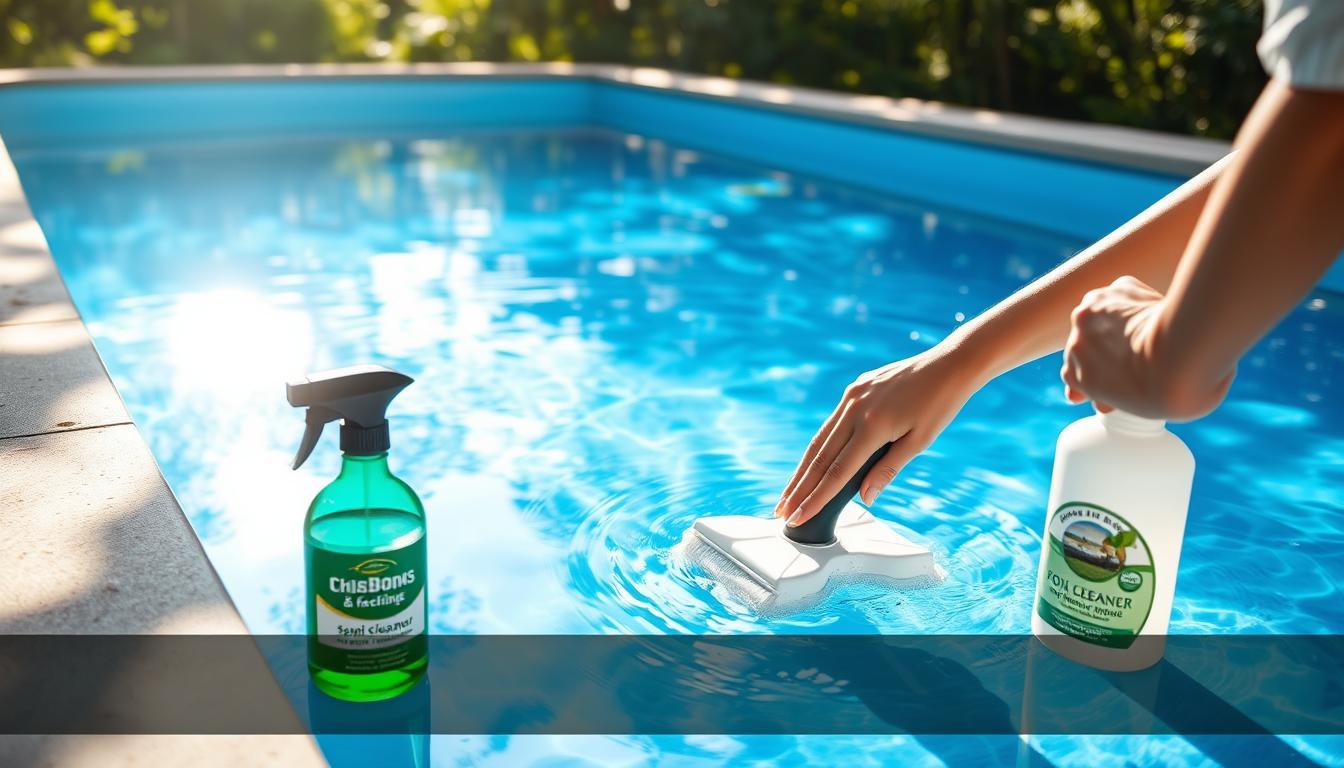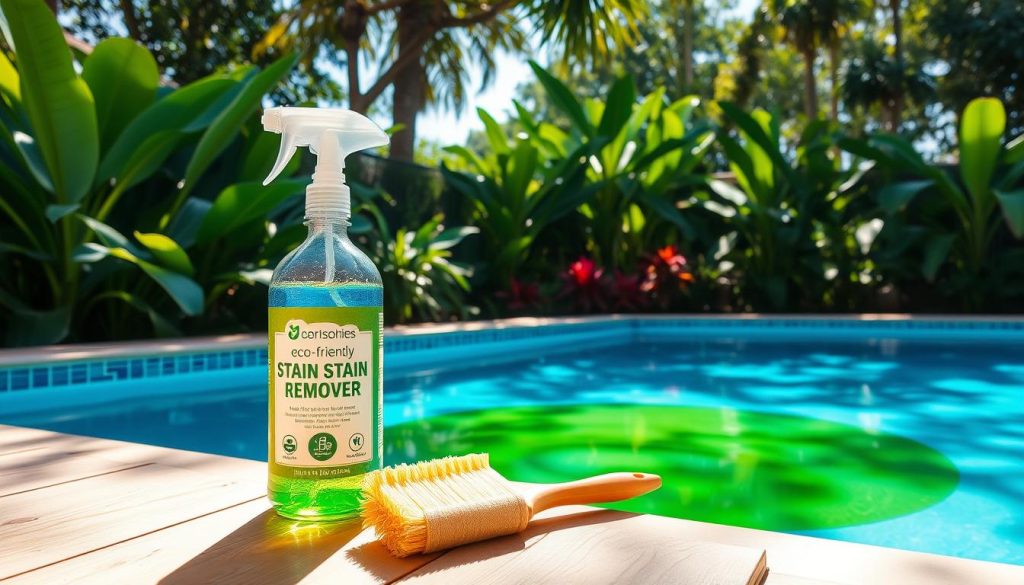
Organic matter like leaves, algae, and insects cause over 70% of pool stains. Stubborn stains can be frustrating when you want to swim. But draining your pool isn’t always needed to tackle these unsightly blemishes.
We’ve listed effective pool stain removal methods to restore your pool’s sparkle. These solutions work without the hassle of emptying your pool.
Different stains need different treatments. Green water discoloration comes from algae. Rusty streaks result from metal buildup. Each type of stain has a targeted solution.
Identify the stain’s nature and apply the right treatment. You’ll say goodbye to pesky marks and hello to a pristine pool.
Solutions range from shocking the water to using specialized products like ascorbic acid. We’ll guide you through the best pool water stain remedies. You’ll learn pool algae stain hacks too.
Get ready to enjoy a crystal-clear oasis without draining your pool!
Identify the Type of Pool Stain
Pool stains can be frustrating. Identifying the stain type is key to finding the right treatment. Let’s explore various stains to keep your pool looking its best.

Organic Stains
Organic stains are the most common. They’re caused by leaves, algae, or other organic matter. These stains are usually greenish-brown and can be removed with chlorine or cleaning products.
To prevent organic stains, maintain balanced water chemistry. Regular cleaning and skimming are also essential.
Metal Stains
Metal stains come from iron, copper, or manganese in pool water. Colors range from dark reddish-brown to turquoise or teal-blue. Removing metal stains requires testing water and using specific removers.
Rust Stains
Rust stains are caused by iron in the water. They appear as reddish-brown spots. To remove rust stains, lower chlorine levels and use a pool-specific rust remover.
Mineral Stains
Mineral stains are white or grey deposits on pool surfaces. They’re caused by calcium or magnesium buildup. Regular brushing and proper water balance help prevent mineral stains.
Waterline Stains
Waterline stains come from dirt, debris, and oils. They can be tough to remove. Regular cleaning and brushing help prevent their formation.
For stubborn waterline stains, use a targeted pool liner cleaning product.
| Stain Type | Appearance | Cause |
|---|---|---|
| Organic | Greenish-brown | Leaves, algae, organic matter |
| Metal | Dark reddish-brown, turquoise, teal-blue | Iron, copper, manganese in water |
| Rust | Reddish-brown spots | Iron in water |
| Mineral | White or grey deposits | Calcium, magnesium accumulation |
| Waterline | Ring around waterline | Dirt, debris, oils from contaminants |
Knowing the stain type helps choose the best treatment. Quick action and regular upkeep keep pools inviting. Your pool will stay pristine for years to come.
Test the Pool Stain
Identify the stain type before removing it without draining. Testing helps determine the stain’s nature. This guides you in choosing the most effective treatment method.
Reactions to Different Granular Compounds
Sprinkle various granular compounds on the stained area. Brush vigorously to observe reactions. This process helps categorize the stain and select the right removal technique.
- Organic stains react to and are removed with granular chlorine
- Metallic stains are removed with granular Vitamin C (ascorbic acid)
- Rust stains react to dry acid or sodium bisulfate
Treating Organic Stains
For organic stains, use a triple dose of calcium hypochlorite shock. Add 3 pounds of shock per 10,000 gallons of water. Brush the surface thoroughly and let it work for 24-48 hours.
Treating Metallic Stains
Use a metal pool stain remover for copper, iron, or manganese stains. These products remove metals from water and prevent settling. Follow the manufacturer’s instructions for dosage and application.
Consider local water testing to identify specific metals causing stains. This can enhance the treatment’s effectiveness.
Treating Rust Stains
Treat rust stains with dry acid and brushing. Apply dry acid directly to the stain and brush vigorously. Repeat if needed for stubborn stains.
You can also use a pumice stone after applying dry acid. Test in an inconspicuous area first to avoid surface damage.
Removing stains without draining saves time and money. It prevents issues like shell etching and algae growth. Regular water chemistry testing helps prevent future stains.
How to Remove Pool Stains Without Draining
Pool stains can be frustrating. Good news! You can often remove them without draining your pool. Let’s explore effective methods for tackling different stain types.
Shocking or Super-Chlorinating for Organic Stains
Organic stains from leaves or algae? Try shocking your pool. This raises chlorine levels briefly to break down contaminants. Follow product instructions carefully.
Let chlorine levels return to normal before swimming. This method is highly effective for organic stains.
Using Ascorbic Acid for Metal Stains
Metal stains from iron or copper? Try ascorbic acid (Vitamin C). Find it at pool supply stores. Sprinkle it on the stain.
Let it sit briefly, then gently scrub. Repeat if needed. This natural solution is safe and effective.
Scrubbing Mineral Stains with Vinegar and Water
For mineral stains like calcium deposits, mix equal parts white vinegar and water. Apply the mixture and wait 15 minutes.
Gently scrub with a soft brush. Rinse thoroughly. For tough stains, add baking soda to make a paste.
Treating Waterline Stains with Salt and Lime Juice
Tackle pinkish waterline stains with salt and lime juice. Mix equal parts to create a paste. Apply to the stain.
Wait an hour, then scrub gently. Rinse well. Repeat if needed. This method works well for pool perimeter stains.
No-Drain Acid Wash for Stubborn Stains
For severe stains, try a no-drain acid wash. This lowers pool water pH to remove stains and scale.
- Lower pH to 1.0 using sodium bisulfate.
- Scrub stained areas for 3 days.
- Raise pH slowly over 18-36 hours.
- Test and adjust water chemistry.
This process removes a thin surface layer. Use sparingly. Consider professional help if unsure.
These techniques effectively treat various stains without draining. Regular maintenance and water testing help prevent future staining issues.
Conclusion
You can remove pool stains without draining by using the right knowledge and tools. Identify the stain type: organic, metallic, rust, mineral, or waterline. Test reactions to granular compounds to find effective remedies. Organic stains respond well to shocking or super-chlorinating the pool.
Metal stains can be treated with ascorbic acid. Use vinegar and water for mineral stains. Salt and lime juice work on waterline stains. For tough stains, try a no-drain acid wash, but be careful.
Keep pH levels between 7.2 and 7.8 to prevent stains. Use robotic pool cleaners like the Beatbot for maintenance. These cleaners work on various pool surfaces and remove set-in stains over time.
Understanding stain removal and maintaining a routine helps keep your pool clean all season. Always read product instructions and safety precautions before use. With the right approach, you can have a great-looking pool without draining it.







